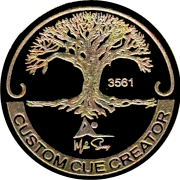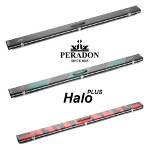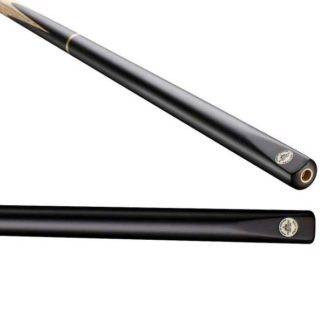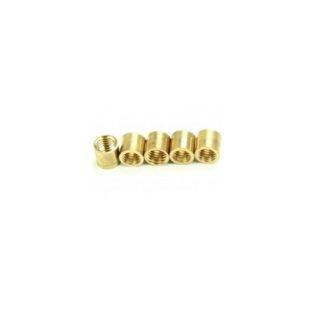Once you purchase a Cue, maintenance is needed as they don’t take care of themselves. For all cues there’s a few simple rules that need to be applied to.
- NEVER leave your cue in a hot place like a car due to that the timber will warp. That also applies to extreme cold as well
- DON’T lean you cue against a wall as it will bend and could also fall down and affect the joint tip or ferrule
- MAINTAIN your cue by cleaning and oiling the cue checking that the joints are clean as well as a good ferrule
- TIP burnish the side of your tip and keep it in good order and check a few weeks before an event that its going to be in good order before it and you have got used to it.
- CHECK cues by sighting down like a gun barrel this way you can see more than any other method. A common belief is to roll it on a table but that’s not as accurate as sighting along the cue
- Use a non Porous glue on your tip as standard super glue will both rot the wood in your shaft and affect the leather in the cue tip.
Storing your cue
When at home we recommend hanging you cue and that’s for a few good reason. If you should leave your cue in a case it will over time conform to the shape inside the case and also if not used it could also get wet and rot the timber like i have seen quite a lot.
It’s quite a easy process to put a hook up on the wall and this method keeps the cue straighter as the weight of the cue is pulling down.
Maintaining the shaft and Tip Installation
Maintaining your shaft for both snooker and pool is very important. Many shafts I see have absolutely no care taken of all and the ash is all opened up or the maple is stained in chalk residue.
For Ash cues unlike what some columns write the oil used by Peradon and other is Boiled linseed oil and yes it does use accelerators but the normal linseed oil doesn’t work very well. Most cue makers want to sell their own oil so make up their own solutions for people to say they use a particular brand.
I also recommend the McDermott cue cleaners and wax.
As John Parris stated you can use a towel to wipe down your cue but you also need to make sure you have a very good well oiled cue.The use of a damp cloth on open grained ash will prove to be a disaster.
Other things that are used are danish oil, shellac and with the cheaper cue makers they also coat the shafts.
If you have bought a cheaper cue that has a vanished shaft you’ll need to use a sandpaper in a 240 grade to start with and then a wet and dry 600 grade followed by 1200. After that you need to oil the cue.
When oiling you’ll notice that the oil dries very quick to start with and you may need up to 10 coats until it doesn’t look like drying. At this stage you need to rub and rub to get the oil tacky finish off and it takes time but once done you will only need to re oil every 2 years or more.
This can take 3 days to do from start of oiling to finish and then re tip.
The other thing that many of the top cue makers use is a wax and rubbing that with a cloth helps seal the cue and works great on both maple and ash. The use of a leather pad and turning the cue helps seal or burnish the cue and it slide through your hand much better.
The Cue Joints and ferrule
The cue joints are often neglected but they also need to be cleaned and make sure that the surfaces have nothing on them. If this isn’t done you’ll find the cue could be making noises that it shouldn’t and may sound like a ferrule issue. To clean just like your ferrule use 600 to 1200 grade sandpaper.
For the ferrules for pool we have a product from Mezz to clean the plastic ferrules. For both plastic Nine ball ferrules and brass you will need to use a 600 and 1200 grade sandpaper.
Always check the ferrule for any movement before re fitting a tip.
Pool Cue Maintenance Tips from McDermott
The Tip
Probably the most important part of the pool cue is the tip. A tip should be shaped in a convex manner to help create maximum cue ball response on all shots. The tip should also be kept coarse allowing chalk to adhere to it. When using any tool to shape and scuff your tip, always follow the manufacturer’s instructions. Once the side wall of the tip becomes thinner than a dime, the tip should be replaced.
– note always use a non porous glue and standard super glues will rot the shaft wood and also affect the cue tip. We have the correct glue on our site only.
The Shaft
Through use of the cue, the shaft may become soiled. There are many products available to clean the shaft of the cue. Avoid using products containing waxes or oils, such as silicone and lanolin. Application of these products will break down the structure of the wood causing it to soften and decay. We recommend the use of McDermott Renew and Ultraglide. Regular use of McDermott McMagic, our hi-tech abrasive films, will smooth the shaft and make it less likely to absorb dirt.
The Joint
When the cue is not in play, we suggest the use of Joint Protectors. Joint protectors serve 2 purposes.
- To protect the joint pin and shaft threads from any damage.
- To seal off the unfinished end of the shaft from moisture.
The Butt
The Irish Linen wrap works to absorb moisture from the player’s hands. We recommend your cue be re-wrapped after extended use to keep a clean absorbent surface on the butt of the cue.
Proper Storage
The cue should be stored in consistent temperature and moisture conditions. Extreme temperatures or humidity will cause warpage. If the cue is being stored on a wall mounted rack, be sure it is kept perfectly straight nut i don’t recommend racks. Avoid wall mounted racks that are installed on an outside wall. For extended storage, use a carrying cue case laid on a flat surface, leaving the case open to allow movement of air.
Do not leave in Car in heat or cold or leaning against a wall.
The Tip
The tip there are so many from single layered to pressed tips. Its the most important part of the cue so it requires the most attention and making sure its a good shape and consistency for the cue.
There are three main cue tips used today.
- One Piece Leather tips
- Layered tips
- Phenolic tips
The price you pay for the tip won’t make it the best for the cue your using. Only trial and error will help you find what works best on your cue. Any time you hit the ball of center the tip needs to grip the cue ball to be able to transfer the spin required. A tip that is not maintained and is flat,shiny too round will produce a miscue and so will a quick uneven fluid stroke.
Some important tools are the Kamui Gator Grip and the two in one tip tool to use to help build up a major amount of chalk or glazing over of the tip.
Pressed Tip
- The most commonly used tip in this area is Elk Master tips and is definitely the most popular tips. Here in Australia we have had batches of tips as Elk Master has stated to me are copies.
- For that reason you’ll see we have the cue creator tip which out performs any tips below in pressed or laminates by providing far better feedback. Also available in Soft, Medium and Hard.
- Blue diamond tips are a good tip but like the elk it takes some finding and you will become an expert at changing tips. Overall i don’t like them as much as a Elk Master tip and we Believe you’ll find more elk masters in a packet of 50 than blue diamond tips.
- Diamond Plus tips are made for one company and are very well liked. This is a old type feel like the previous made blue diamond tips and made by tweeten. I have many people using these tips and they are well like by billiard players for the feel of them.
- Pro Granite tips are for the people that like a very hard tip. I sell quite a lot of these tips but I have never liked a overly hard tip but many people do.
Laminated Tips Snooker
I have found that laminated tips provide more control and off centre striking you can get away with more as they compress more evenly. They definitely last a lot longer with the correct care and with these tips you use different tools for them.
The most important part with laminated tips is to keep the side walls even with the ferrule and using a leather pad and burnishing liquid to seal the edges of the tip. Doing this will maximise the life of the tip by a long way.
- The most tips I would sell overall in this section would be the tips from phoenix black tips which come in a soft which I don’t like and a medium which start as a medium and goes harder. These Medium tips are very popular and used by James Mifsud and Steve Ebejer and many other top Australian Players
- Phoenix reds are also very popular and are a medium rating and stay that way and hold their shape very well. These tips are becoming very popular and I have just ordered a lot of stock as in the past few months many people have ordered them.
- Mui tips from Phoenix are a softer feel and cut and shape very well and if you like a softer tip then these are a good option
- Talisman – I have these in soft, medium and hard and you need to really try out what works better on your cue. I have found the Hard the tip I like the most and found they hold their shape very well.
- G2 tips are a newer tip from Japan and I sell a fair few in soft and some in hard. These are a flat tip and you need to shape the tips but they do last a long time.
- Kamui tips are popular tips and we have these in the black and originals which are one of the most used in laminates today.
Laminated Tips for Pool
- G2 Tips Snooker and Pool consist of 8 layered pigskin and is designed for the player that wants feel, control, and consistency. Made in Japan with three different ratings in pool 14mm tips and Soft and a Medium for snooker. These tips are becoming more popular in Japan,USA and England.
- These Kamui Tips -Snooker and Pool are specially selected 10 layered pig skin. The leather is tanned by a special moisture proof tannin and they are made in Japan.
- Predator Victory Pool Cue Tips come from a range of tips from the well know brand of cues Predator. The Predator Victory tips consist of 8 layers and are a Laminated tip with a colour that stands out and aids in sighting.
- This Everest Pool tip is selected by many companies including Predator as their first choice in presenting their new cues and the play very well.









